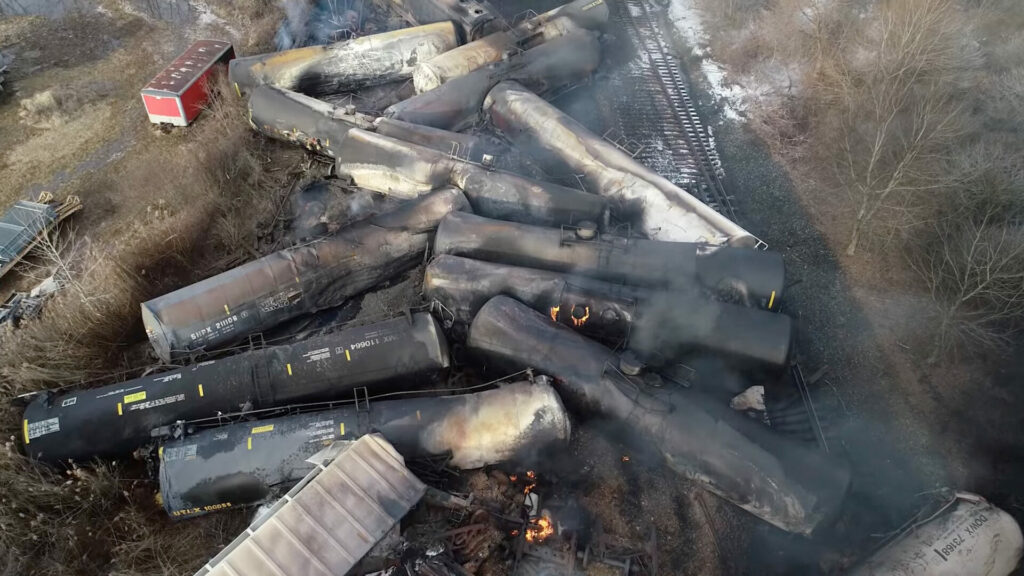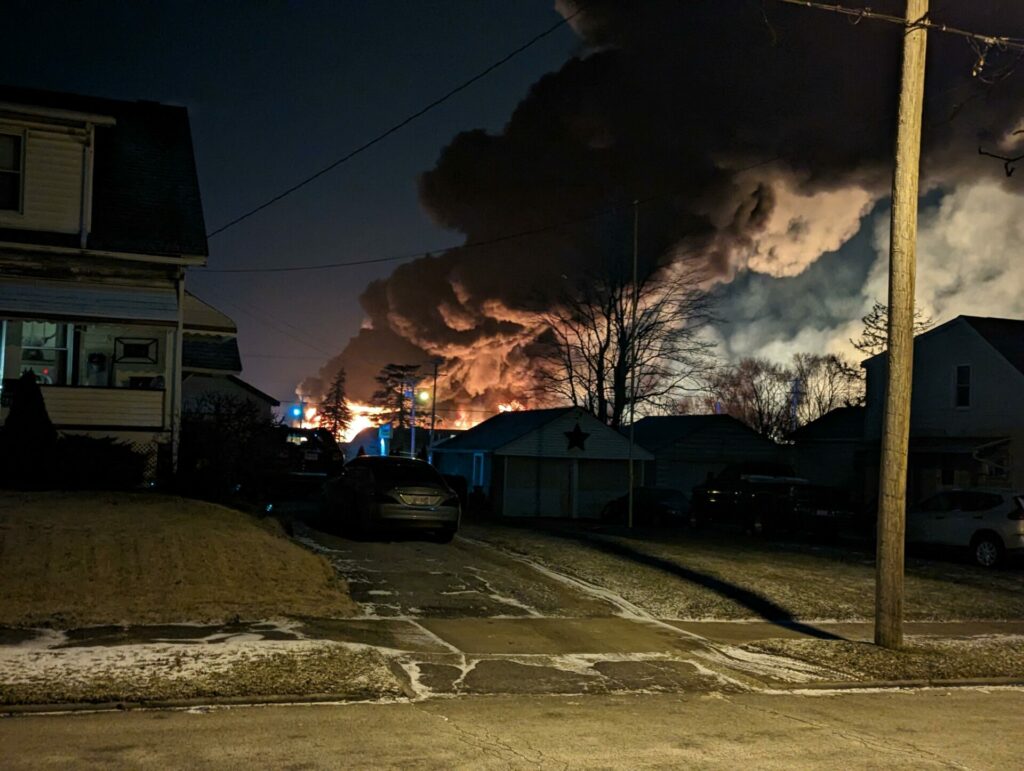
On February 3, 2023, a Norfolk Southern train carrying over 100,000 gallons of various chemicals derailed in the town of East Palestine, Ohio. This resulted in a rapid response as a number of organizations acted to ensure the health and safety of the local residents (Hauser, 2023; Tabuchi, 2023; U.S. Environmental Protection Agency (EPA), 2023a). Within a few days, five of the train cars carrying vinyl chloride had their materials released and ultimately incinerated to prevent a more widespread explosion (Tabuchi, 2023). The fire that occurred was the focus of media attention for many days. Citizens were concerned and most had evacuated.
It has been reported that of the 150 cars on the Norfolk Southern train, 38 were derailed in the initial incident and an additional 12 were damaged in an ensuing fire (Hauser, 2023). Approximately 20 cars on the train were carrying industrial chemicals, including vinyl chloride, polypropylene, ethylhexyl acrylate, polyethylene, dipropylene glycol, propylene glycol, diethylene glycol, polyvinyl, polypropyl glycol, isobutylene, butyl acrylates, petroleum oil, fuel additives, and benzene (U.S. Environmental Protection Agency (EPA), 2023b) Other cars held products ranging from paraffin wax to frozen vegetables (U.S. Environmental Protection Agency (EPA), 2023b). Some of the consumer products in the cars were damaged or destroyed, but some remained undamaged and unburned, leaving individual companies to decide on how to handle disposal or sale of those products.
Of the industrial chemicals leaked in the derailment, vinyl chloride drew immediate attention due to its combustion risk and toxicity. For days, the community expressed a range of concerns about inhaling the airborne chemicals, as well as the products of combustion. Some were concerned about their drinking water while others worried about the soil contaminants and the possible effects on their gardens. Many complained that communications with citizens were inadequate. Erin Brockovich and others seemed to encourage citizens to consider personal injury litigation.

For the firms involved in the incident, it has been reported that they will be answering questions about whether the responses were adequate, whether citizens in the community were overexposed to any chemicals and the possible adverse health effects for several years. Numerous lawsuits have already been filed against Norfolk Southern Railway Company and many firms who had had chemicals in some of the cars.
Toxicology is built around the concept of dose. This will be critical to understanding the hazards, or lack thereof, posed by these leaked or combusted chemicals. This will require an appropriate scientific analysis of how the chemicals spread from the initial derailed train cars and the types of chemicals in the combustion products. It will be necessary to characterize the fate/transport of gases and particles from the plume. A toxicological profile of each of the chemicals will be necessary and a quantitative estimate of dose will need occur. Ultimately, the potential health risks and probability that adverse effects experienced by community members and responders, if any, will need to be characterized. This approach is called a health risk assessment.
How Paustenbach & Associates Can Help
Scientists at Paustenbach & Associates have over 50 years of experience in conducting risk assessments of environmental and occupational contaminants, including vinyl chloride and benzene, in the workplace, ambient environment, and point source emissions. They have been involved in hundreds of risk assessments and have offered testimony about their analyses in hundreds of court cases. We have often published our analyses in peer reviewed journals (Benson et al., 2018; Greene et al., 2003; Gross & Paustenbach, 2018; Monnot et al., 2016; Novick et al., 2013; Panko et al., 2009; Paustenbach et al., 2006; Paustenbach & Gibbons, 2022; Paustenbach & Kerger, 2013; Paustenbach, Meyer, et al., 1991; Paustenbach, Rinehart, et al., 1991; Paustenbach et al., 1986; Sahmel et al., 2010; Sheehan et al., 1991) .
In the cases for which we were retained, we applied exposure science and the health risk assessment methodology embraced by the National Academy of Science to characterize the possible risks. Among our abundance of experience with performing risk assessments is our evaluation of a community exposed to a refinery fire in Northern California (Paustenbach, 2012). We have published numerous papers on some of the chemicals alleged to be of concern at this site including airborne benzene, toluene, ethylbenzene, and xylene (all alleged to be important in the Deepwater Horizon oil spill) (Avens et al., 2011). We have also evaluated the potential health hazards to a community following an unexpected nearby release of gaseous vinyl chloride and benzene due to landfill gases. Our experience has shown that there will be claims about the presence of PAHs, dioxins and furans in the soot that was distributed for miles around the fire. No one has more experience in dealing with this family of chemicals (see references). Please contact Grayson Abele for more information regarding our capabilities at gabele@paustenbachandassociates.com or 303-598-0998.
References
Benson, S. M., Ruestow, P., Keeton, K. A., Novick, R. M., Marsh, G. M., & Paustenbach, D. J. (2018). The 2014 crude 4-methylcyclohexanemethanol chemical release and birth outcomes in West Virginia. Arch Environ Occup Health, 73(5), 292-301. https://doi.org/10.1080/19338244.2017.1350132
Greene, J. F., Hays, S., & Paustenbach, D. (2003). Basis for a proposed reference dose (RfD) for dioxin of 1-10 pg/kg-day: a weight of evidence evaluation of the human and animal studies. J Toxicol Environ Health B Crit Rev, 6(2), 115-159. https://doi.org/10.1080/10937400306470
Gross, S. A., & Paustenbach, D. J. (2018). Shanghai Health Study (2001-2009): What was learned about benzene health effects? Critical Reviews in Toxicology, 48(3), 217-251. https://doi.org/10.1080/10408444.2017.1401581
Hauser, C. (2023, March 31, 2023). How the Ohio Train Derailment and Its Aftermath Unfolded. The New York Times.
Monnot, A. D., Tvermoes, B. E., Gerads, R., Gürleyük, H., & Paustenbach, D. J. (2016). Risks associated with arsenic exposure resulting from the consumption of California wines sold in the United States. Food Chemistry, 211, 107-113. https://doi.org/10.1016/j.foodchem.2016.05.013
Novick, R. M., Keenan, J. J., Gross, S. A., & Paustenbach, D. J. (2013). An analysis of historical exposures of pressmen to airborne benzene (1938-2006). Ann Occup Hyg, 57(6), 705-716. https://doi.org/10.1093/annhyg/mes107
Panko, J. M., Gaffney, S. H., Burns, A. M., Unice, K. M., Kreider, M. L., Booher, L. E., Gelatt, R. H., Marshall, J. R., & Paustenbach, D. J. (2009). Occupational Exposure to Benzene at the ExxonMobil Refinery at Baton Rouge, Louisiana (1977–2005). Journal of Occupational and Environmental Hygiene, 6(9), 517-529. https://doi.org/https://doi.org/10.1080/15459620903044161
Paustenbach, D. J. (2012). Evaluating the health risks to the community associated with a refinery fire in Richmond, Cal. (Unpublished).
Paustenbach, D. J., Fehling, K., Scott, P., Harris, M., & Kerger, B. D. (2006). Identifying Soil Cleanup Criteria for Dioxins in Urban Residential Soils: How Have 20 Years of Research and Risk Assessment Experience Affected the Analysis? Journal of Toxicology and Environmental Health, Part B, 9(2), 87-145. https://doi.org/10.1080/10937400500538482
Paustenbach, D. J., & Gibbons, R. D. (2022). Radiological risk assessment of the Hunters Point Naval Shipyard (HPNS). Critical Reviews in Toxicology, 1-47. https://doi.org/10.1080/10408444.2022.2118107
Paustenbach, D. J., & Kerger, B. D. (2013). The University of Michigan Dioxin Exposure Study: Estimating residential soil and house dust exposures to young children. Chemosphere, 91(2), 200-204. https://doi.org/10.1016/j.chemosphere.2012.12.047
Paustenbach, D. J., Meyer, D. M., Sheehan, P. J., & Lau, V. (1991). An assessment and quantitative uncertainty analysis of the health risks to workers exposed to chromium contaminated soils. Toxicol Ind Health, 7(3), 159-196. https://doi.org/10.1177/074823379100700304
Paustenbach, D. J., Rinehart, W. E., & Sheehan, P. J. (1991). The health hazards posed by chromium-contaminated soils in residential and industrial areas: conclusions of an expert panel. Regul Toxicol Pharmacol, 13(2), 195-222. https://doi.org/10.1016/0273-2300(91)90022-n
Paustenbach, D. J., Shu, H. P., & Murray, F. J. (1986). A critical examination of assumptions used in risk assessments of dioxin contaminated soil. Regul Toxicol Pharmacol, 6(3), 284-307. https://doi.org/10.1016/0273-2300(86)90019-x
Sahmel, J., Devlin, K., Paustenbach, D., Hollins, D., & Gaffney, S. (2010). The role of exposure reconstruction in occupational human health risk assessment: Current methods and a recommended framework. Critical Reviews in Toxicology, 40(9), 799-843. https://doi.org/10.3109/10408444.2010.501052
Sheehan, P. J., Meyer, D. M., Sauer, M. M., & Paustenbach, D. J. (1991). Assessment of the human health risks posed by exposure to chromium-contaminated soils. J Toxicol Environ Health, 32(2), 161-201. https://doi.org/10.1080/15287399109531476
Tabuchi, H. (2023, April 17, 2023). Texas to New Jersey: Tracking the Toxic Chemicals in the Ohio Train Inferno. The New York Times.
U.S. Environmental Protection Agency (EPA). (2023a). Daily Updates: East Palestine, Ohin Train Derailment. U.S. Environmental Protection Agency. https://www.epa.gov/east-palestine-oh-train-derailment/daily-updates
U.S. Environmental Protection Agency (EPA). (2023b). Train 32N – East Palestine Derail List. U.S. Environmental Protection Agency. https://www.epa.gov/system/files/documents/2023-02/TRAIN%2032N%20-%20EAST%20PALESTINE%20-%20derail%20list%20Norfolk%20Southern%20document.pdf
© 2020 All rights reserved